The role of Allied combat aviation in the fight against German tanks
During the battles in North Africa, it turned out that the British aviation It has a low anti-tank potential. Bombers striking productively at transport hubs, military camps, warehouses and artillery positions proved to be ineffective against the German tanks, since the probability of a direct hit or at least a gap in the immediate vicinity of the tank was small. A squadron of Blenheim bombers, each of which usually carried four 250 lb (113 kg) bombs, when bombing from horizontal flight from a height of 600-1000 meters, could destroy or seriously damage 1-2 tanks. Low-altitude bombing was usually not used due to the lack of bombs with special fuses and braking devices.
The Hurricane fighters with cannon armament, which were sufficiently effective against transport convoys, could not fight with enemy tanks. The armor of German tanks turned out to be too tough for the 20-mm shells of aircraft cannons. As practice has shown, even when penetrating the relatively thin armor of Italian tanket and armored vehicles, the armor’s projectile action was not enough to destroy or prolonged armored vehicles.
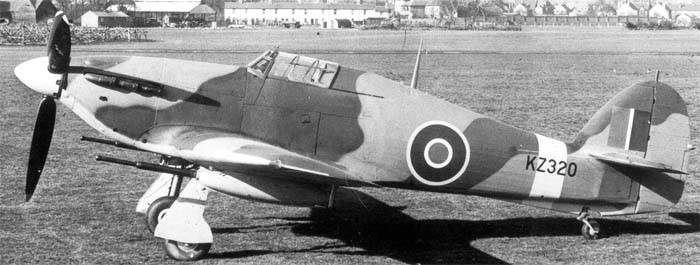
The experience of using the Hurricane IID fighter-bomber in Tunisia with two 40-mm Vickers S cannons was not very successful. Ammunition 15 shells allowed to make 2-3 combat approach to the target. From a distance of 300 m, an armored-piercing projectile of the Vickers S cannon pierced 40 mm armor along the normal. But when firing at a single tank, experienced pilots could at best manage to hit one or two shells. It was noted that due to strong recoil dispersion when firing is too large and accurate shooting is possible only the first shots in the queue. Even in the case of falling into the medium German tank, its destruction or incapacitation was not guaranteed, since when firing from a gentle dive, due to the large angle between the armor and the projectile, there is a high probability of rebounding. The flight data of the Hurricane IID with the “big guns” was worse than that of a fighter with conventional weapons, and the effectiveness is questionable, and therefore the anti-tank variant was not widely used.
Soon the British and Americans came to the conclusion that the creation of specialized anti-tank attack aircraft with cannon armament was futile. The crushing return of large-caliber aircraft guns did not allow for an acceptable accuracy of firing all the projectiles in the queue, the ammunition for such guns was very limited, and the large mass and significant frontal resistance of large-caliber guns worsened flight characteristics.
After Germany attacked the USSR from the Eastern Front, information began to be received on the large-scale use of rockets in the Red Army air forces. At that time, in the UK, 76-mm fragmentation anti-aircraft missiles with a remote fuse were already in service. They had a simple design and were cheap to manufacture. In fact, it was a water pipe with stabilizers, 5 kg of cordite of the SCRK brand was used as a solid fuel in the rocket. Despite the primitive design, 76-mm anti-aircraft missiles proved to be quite effective in maintaining barrage anti-aircraft fire.
RP-3 aircraft missiles based on an anti-aircraft missile had several variants of combat units. At the first stage, two replaceable warheads for various purposes were created. Armor-piercing 25-pound (11,35 kg) solid steel bar of 3,44 caliber inches (87,3 mm), accelerated by a jet engine up to speed 430 m / s, up to 1943, could penetrate the armor of any German tank. The sighting range was about 1000 meters. The field tests showed that at a range of 700 meters, a rocket with an armor-piercing warhead punctured the 76 mm armor normally. In practice, the launch of missiles on enemy tanks was usually made at a distance of 300-400 meters. The striking effect, in the case of penetration, intensified continued burning with cordite sustainer engine. For the first time, the British used armor-piercing aircraft missiles in June 1942. The probability of hitting a single missile in a tank was low, partly offset by a salvo launch, but in any case the missiles were more effective. weapons against tanks compared to 20-mm aircraft guns.
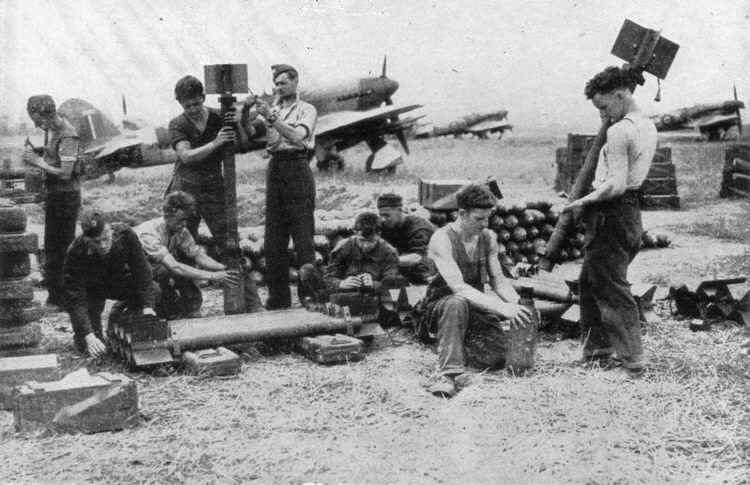
Simultaneously with a solid armor piercing, a high-explosive 60-pound missile was created, its actual mass, despite the designation, was 47 pounds or 21,31 kg. Initially, 60-pound unguided aircraft missiles were designed to combat German submarines in surface position, but it later turned out that with great effect they can be used against land targets. A missile with a high-explosive 60-pound XU caliber 4,5 inch (114-mm) did not penetrate the frontal armor of an average German tank, but when hit to the undercarriage of an 1,36 armored vehicle, the TNT and hexogen alloy proved enough to immobilize the combat vehicle. These missiles showed good results in the storming of columns and the suppression of anti-aircraft batteries, striking airfields and trains.
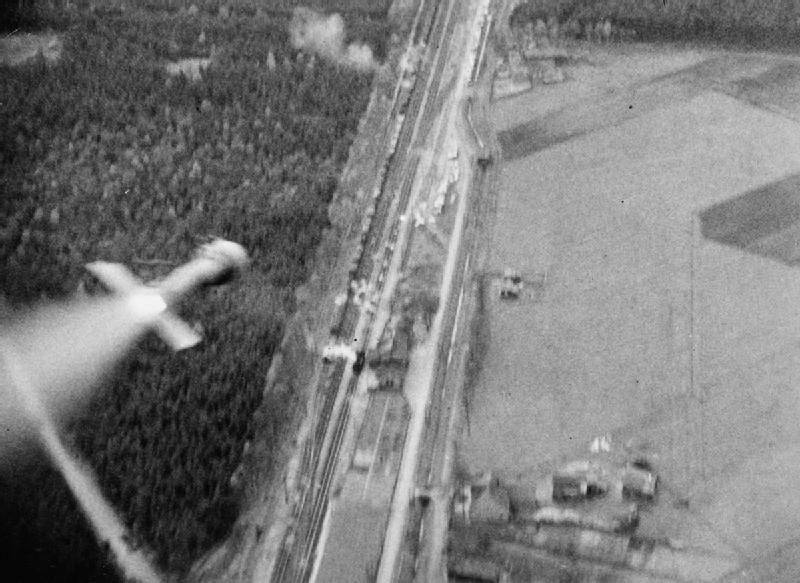
It is also known about the combination of a jet engine with stabilizers and an 114,3-mm incendiary projectile equipped with white phosphorus. If 25-pounder armor-piercing rockets after 1944 were used mainly for training and firing, then 60-pounds were in service with the RAF until the middle of 60-x.
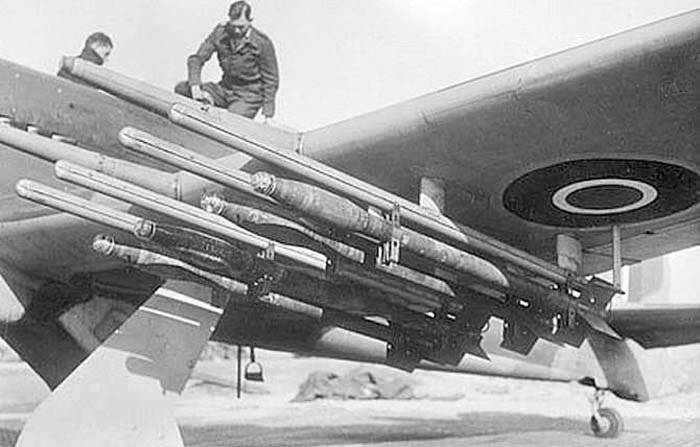
After the appearance of heavy tanks and self-propelled guns in Germany, the question arose of creating new aircraft missiles capable of penetrating their armor. In 1943, a new version with an armor-piercing high-explosive warhead was developed. The 152-mm warhead with an 27,3 kg armor-piercing tip contained 5,45 kg of explosives. Due to the fact that the rocket engine remained the same, and the mass and frontal resistance increased significantly, the maximum flight speed dropped to 350 m / s. For this reason, accuracy was somewhat worsened and the effective firing range decreased, which was partly offset by an increased striking effect.
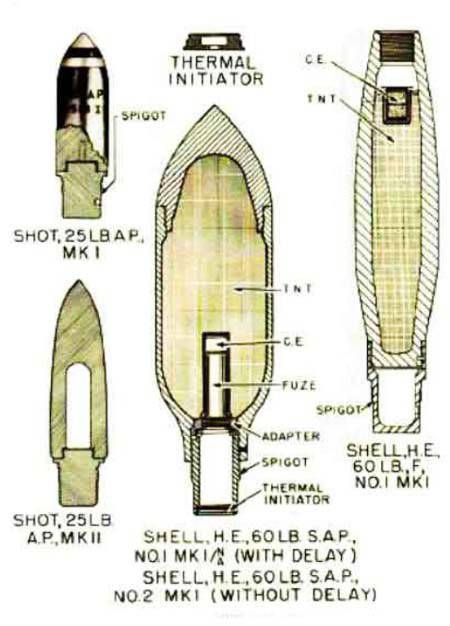
Replaceable combat units of British aircraft rocket projectiles. Left: 25-pound armor-piercing, at the top - "25lb AP rocket Mk.I", at the bottom - "25lb AP rocket Mk.II", on the right: high-explosive 60-pound "60lb NOT No1 Mk.I", in the middle: armor-piercing -foghun-fugue 60-NOT 60 Mk.I; - pound "2lb NoXNUMX Mk.I"
152-mm high-explosive armor-piercing missiles confidently hit the German "Tigers". If hit in a heavy tank did not lead to armor penetration, he still received heavy damage, the crew and internal units were often hit by internal chipping of armor. Thanks to a powerful warhead, the undercarriage was destroyed at close break, optics and armament were knocked out. It is believed that the cause of death of Michael Wittman - the most effective German tank ace, was hit in the stern of his "Tiger" missiles from the English fighter-bomber "Typhoon".
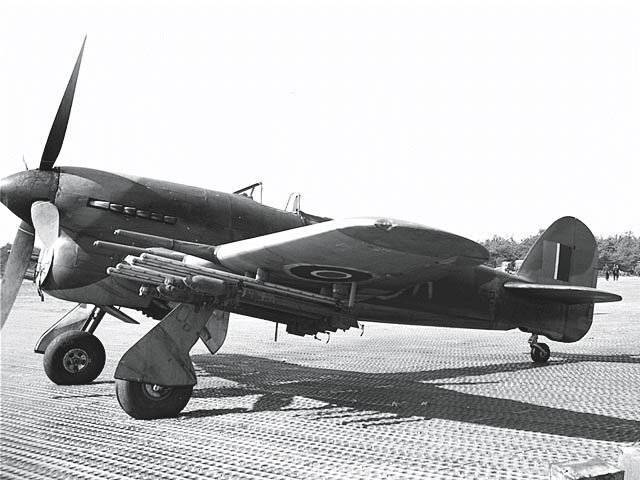
For the effective use of armor-piercing high-explosive missiles, it was necessary to have some experience. The most trained pilots of British fighter-bombers were involved in the hunt for German tanks. When launching heavy missiles with 152-mm warhead squander, and this should be considered when aiming. The standard tactic of the British attack aircraft "Tempest" and "Typhoon" was diving at a target at an angle of up to 45 °. Many pilots opened fire on the target with tracer shells to visually determine the line of fire. After that, it was necessary to slightly raise the nose of the aircraft, in order to take into account the rocket’s downfall. Accuracy of firing largely depended on the pilot's intuition and his experience in using rockets. The highest probability of hitting the target was achieved with salvo firing. In March, 1945, aircraft missiles with a cumulative warhead and improved accuracy, but by that time there were few German tanks left, and the new missiles did not have a particular impact on the course of the fighting.
American aircraft missiles used during the Second World War, were much better than the British. The American NAR M8 had no prototypes, like the British RP-3 rocket, it was created from scratch, and was originally developed to arm combat aircraft. Despite the fact that in the USA they started to build their own missiles later than in the UK, the Americans managed to achieve not the best results.
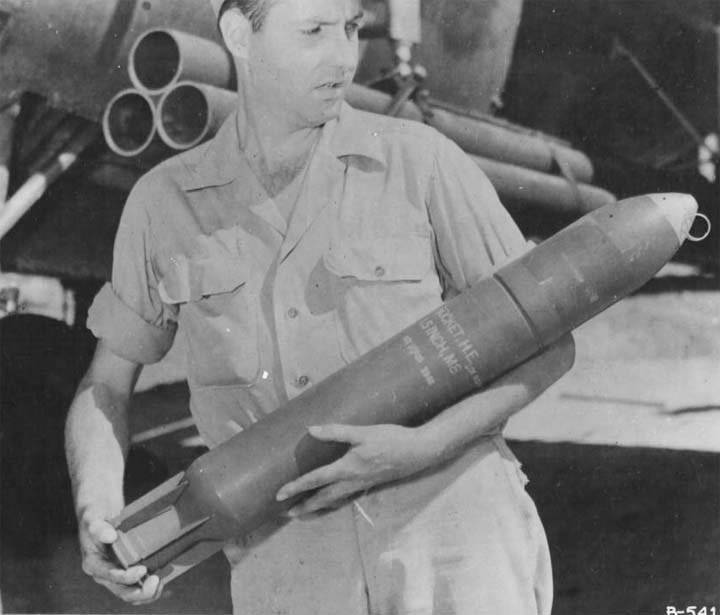
The M8 caliber of 4,5 inches (114-mm) was launched into mass production at the start of the 1943 of the year. With a weight of 17,6 kg, its length was 911 mm. Three dozen powder drafts accelerated the M8 to the speed of 260 m / s. The high-explosive fragmentation warhead contained almost two kilograms of TNT, and the armor-piercing warhead was a monolithic steel pig.
Compared to the primitive British missiles, NAR M8 seemed to be a masterpiece of design thought. To stabilize the M8 on the trajectory, five collapsible spring-loaded stabilizers were used, which open up when the rocket leaves the tubular guide. The folded stabilizers were placed in a narrowed tail section. This allowed to reduce the size and reduce drag when the NAR is suspended on the aircraft. Purging in the wind tunnel showed that tubular-type guides have minimal resistance compared to other types of starting devices. Launch tubes with a length of 3 meters were mounted in a block of three pieces. Launchers were made of different materials: steel, magnesium alloy and plastic. The most common plastic guides had the lowest resource, but they were also the lightest - 36 kg, the steel guide weighed - 86 kg. The magnesium alloy pipe was almost the same as steel pipe, and its mass was close to plastic - 39 kg, but it was also the most expensive.
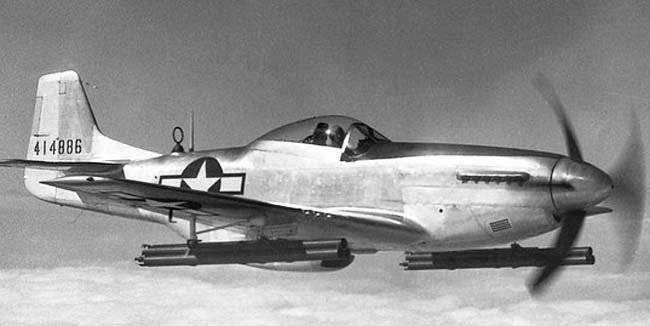
The process of loading the M8 was very simple and took much less time compared to the British RP-3. In addition, the accuracy of firing American missiles was significantly higher. Experienced pilots with a salvo launch with a high degree of probability got into the tank, while before the launch of the missiles it was recommended to make an adjustment with tracer bullets. Taking into account the experience of combat use, at the end of 1943, an improved modification М8А2, and then А3 appeared. The new models of missiles increased the area of folding stabilizers and increased the thrust of the cruising jet engine. The warhead of the rocket, now equipped with more powerful explosives, has increased. All this has significantly improved the accuracy and damaging characteristics of American 114-mm aircraft missiles.
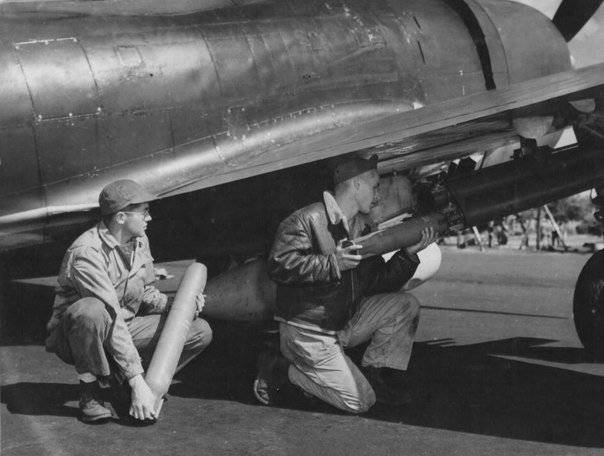
The first carrier of the NAR М8 was the Tomahawk P-40 fighter, but then this rocket became part of the armament of almost all types of US front-line and deck-based aircraft. The combat effectiveness of 114-mm missiles was very high and the M8 was popular among American pilots. So, only the P-47 "Thunderbolt" fighters of the American 12 Air Force during the fighting in Italy spent up to 1000 missiles daily. In total, until the end of hostilities, the industry delivered about 2,5 million of unguided missile systems of the M8 family. The missiles with armor-piercing and armor-piercing-high-explosive warheads were quite capable of penetrating the armor of medium-sized German tanks, but the 114-mm missiles were much more effective when striking German transport convoys.
In the middle of the 1944 of the year, the 3,5 FFAR and 5 FFAR used naval aircraft in the United States to create the 127-mm NAR 5 HVAR (High Velocity Aircraft Rocket), also known as the “Holy Moses ”(“ Holy Moses ”). Its high-explosive fragmentation warhead was essentially an 127-mm artillery shell. There were two types of warheads: high-explosive fragmentation mass 20,4 kg - containing 3,5 kg of explosives and solid armor-piercing - with a carbide tip. The rocket with a length of 1,83 m and a mass of 64 kg was accelerated by a sustainer solid-fuel engine to 420 m / s. According to American data, 127-mm NAR "5 HVAR" with a solid steel armor-piercing warhead was able to penetrate the frontal armor of the German "Tiger", and the high-explosive fragmentation missile guaranteed to destroy the average tanks in a direct hit.
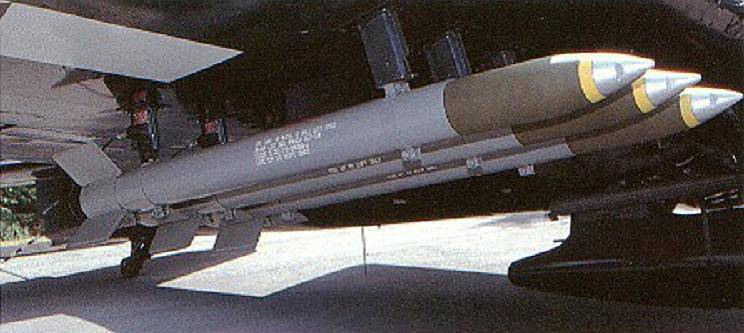
American 127-mm NAR "5 HVAR" in terms of combat and operational characteristics have become the most sophisticated aviation missiles of the Second World War. These missiles remained in service in many countries until the beginning of the 90's and were used in many local conflicts.
The publication is not accidentally paid so much attention to unguided missiles. The Americans and the British did not have special light cumulative air bombs, similar to the Soviet PTAB, which the Soviet Elahs, since the middle of the 1943 year, had beaten out Panzervae tanks. Therefore, it was rockets that became the main anti-tank weapons of the Allied fighter-bombers. However, for strikes on German tank units, two or four engine bombers were often recruited. There are cases when dozens of heavy B-17 and B-24 simultaneously bombed the concentration sites of German tanks. Of course, the effectiveness of bombing armored vehicles with large-caliber bombs from a height of several thousand meters is, frankly, a dubious undertaking. But here the magic of large numbers and the theory of probability played their part, when hundreds of 500 and 1000 pound air bombs fell from the sky at the same time into a limited area: they inevitably covered someone. Given that the allies in 1944 had superiority in the air and a huge number of bombers at their disposal, the Americans could afford to use strategic bomber aircraft to perform tactical tasks. After the Allies landed in Normandy, their bombers soon completely paralyzed the enemy’s railway network and the German tanks, the gas tankers accompanying them, trucks, artillery and infantry were forced to make long marches on the roads while being subjected to the continuous influence of aviation. According to eyewitnesses, the French roads leading to Normandy were cluttered up with broken and broken German vehicles in 1944.
It was the British "Temposts" and "Typhoons", as well as the American "Mustangs" and "Thunderbolts" became the main anti-tank allies. At first, 250 and 500 pounds caliber bombs (113 and 227 kg) were mainly suspended from fighter-bombers, and from April 1944 g. - and 1000-pound (454-kg). But for the fight against tanks in the front line more suitable NAR. Theoretically, in any British Typhoon, depending on the nature of the intended purpose, the bomb racks could be replaced with guides for missiles, but in practice, in each squadron, some of the aircraft were constantly carried by bomb racks, and some were guides. Later on, squadrons specializing in rocket attacks appeared. They were staffed by the most experienced pilots, and German armored vehicles were among the highest priority targets. Thus, according to British sources, on August 7, the Typhoon fighter-bombers attacked German tank units advancing to Normandy during the day and destroyed 1944 and damaged 84 tanks. Even if the British pilots in reality managed to achieve at least half of the declared - it would be a very impressive result.
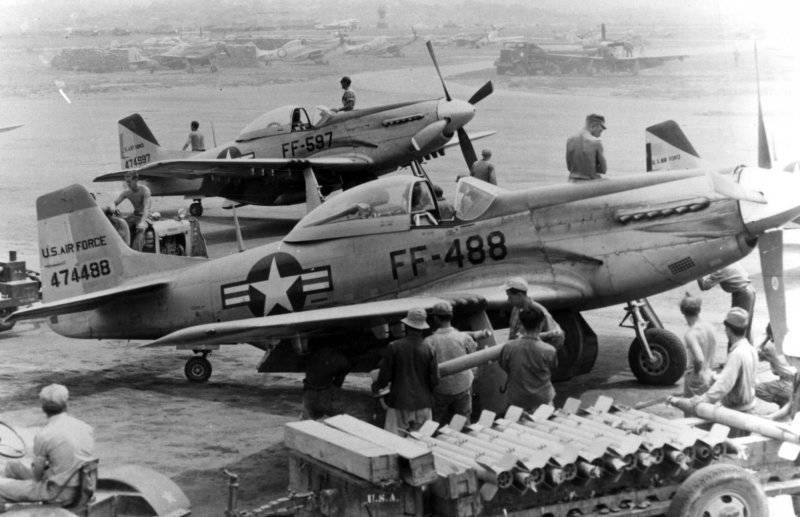
Unlike the British, American pilots did not specifically hunt for armored vehicles, but acted upon requests from the ground forces. A typical American tactic of the P-51 and the P-47 was a sudden attack from a gentle dive of enemy strongholds or counterattacking German troops. In this case, repeated visits to the target, with actions on communications in order to avoid losses from anti-aircraft fire, as a rule, were not performed. American pilots, providing direct air support to their units, inflicted "lightning strikes", after which they carried out care at low altitude.
Here is what Colonel Wilson Collins, commander of the 3 Tank Battalion of the 67 Tank Regiment, wrote about this in his report:
It should be understood that the British and American fighter-bombers were not attack aircraft in the usual sense for us. They did not iron the German troops, making multiple visits to the target, like the Soviet Il-2. Unlike Soviet armored ground attack aircraft, American and British fighter-bombers were very vulnerable to shelling from the ground, even with small arms. That is why they avoided multiple attacks from ground targets. Obviously, with such tactics of the Allies, the accuracy of the use of rocket-bomb weapons left much to be desired, and one should be very wary of the combat scores of many pilots. This is especially true of the accounts of British pilots who flew the Typhoons, since some of them allegedly destroyed dozens of German tanks.
A detailed study of destroyed and burned German tanks showed that real losses from aviation were usually no more than 5-10% of the total number of destroyed combat vehicles, which, in general, is consistent with the results of the ground tests. In 1945, at one of the British test sites, the effectiveness of British aircraft missiles when shooting at the Panther trophy tank was conducted. Under ideal polygon conditions, experienced pilots managed to achieve 64 hits during 5 NAR launch. In this case, the shooting was conducted on a fixed tank, and there was no anti-aircraft resistance.
It can be said with confidence that the effectiveness of the Allied aviation rockets as anti-tank weapons was initially overestimated. For example, a statistical analysis of the actions of 2 of the British tactical air army and 9 of the American air army in the battles of Morten in August 1944 showed that only 43 of German tanks destroyed on the battlefield were hit by a missile air strike. When attacking missiles on a highway in the vicinity of La Baleyn in France, armored convoys of approximately 7 tanks declared the destruction of 50. Already after the Allied forces occupied the area, it turned out that only 17 had been immobilized and only two of them were fatally damaged and could not be restored. This can be considered still a very good result, in other places the ratio of declared and actually wrecked tanks was at times indecent at all. Thus, during the battles in the Ardennes, the pilots announced the destruction of 9 tanks, in fact, from the 66 found in this area of the padded German tank, only 101 was the credit of the aviators, and this despite the fact that as soon as the weather in the area improved, the air strikes followed continuously.
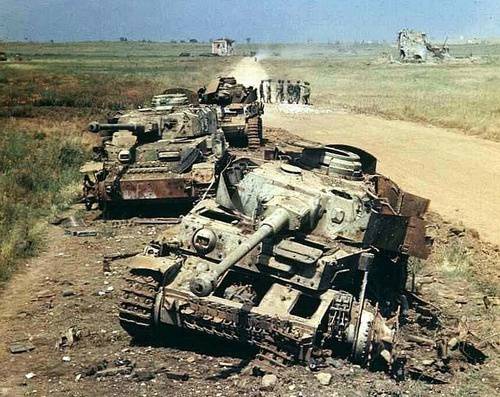
However, the constant air attacks had a debilitating effect on the German tank crews. As the Germans themselves said, on the Western front, they developed a “German look” - tankers, even far from the front line, constantly looked at the sky with anxiety while waiting for an air attack. Subsequently, a survey of German prisoners of war confirmed the tremendous psychological effect of air attacks, especially missile ones, even tank crews consisting of veterans who had previously fought on the Eastern Front were subject to it.
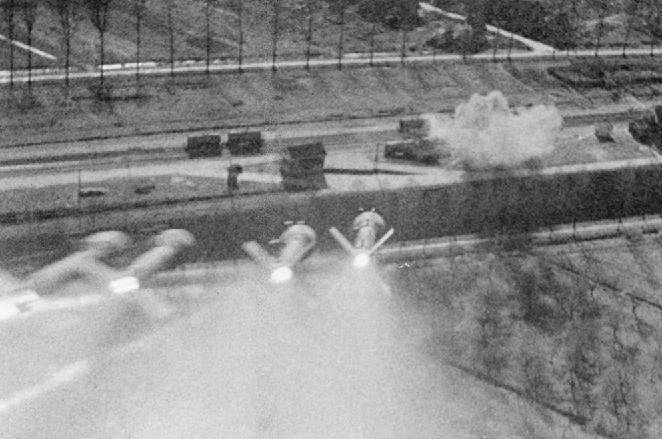
Compared to attempts to directly combat German tanks, attacks against unprotected armor targets such as trains, tractors, trucks and gasoline tank trucks have become much more effective. The fighter-bombers operating on German communications made the movement of German troops, the supply of ammunition, fuel, food and the evacuation of damaged equipment in the daytime during the flying weather absolutely impossible. This circumstance had the most negative effect on the combat capability of the German troops. The German tank crews, winning fire duels with the Shermans and Komet, but left without fuel, ammunition and spare parts, were forced to abandon their cars. Thus, the Allied aviation, which turned out to be not very effective with the direct fire damage of German tanks, was the most effective anti-tank weapon, depriving the Germans of supply. At the same time, the rule was once again confirmed: even with a high fighting spirit and the most advanced equipment, it is absolutely impossible to fight without ammunition, fuel and food.
Based on:
http://ftr.wot-news.com/2014/04/04/ground-attack-aircraft-myth-of-the-tank-busters/
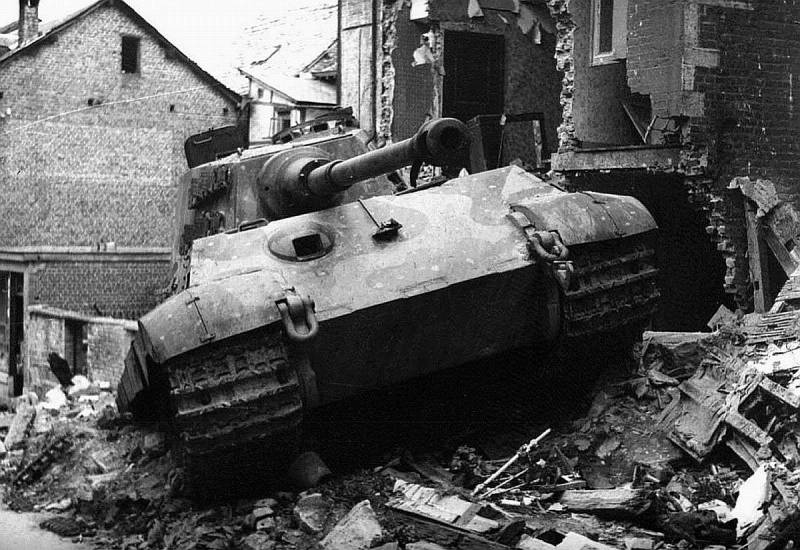
Information